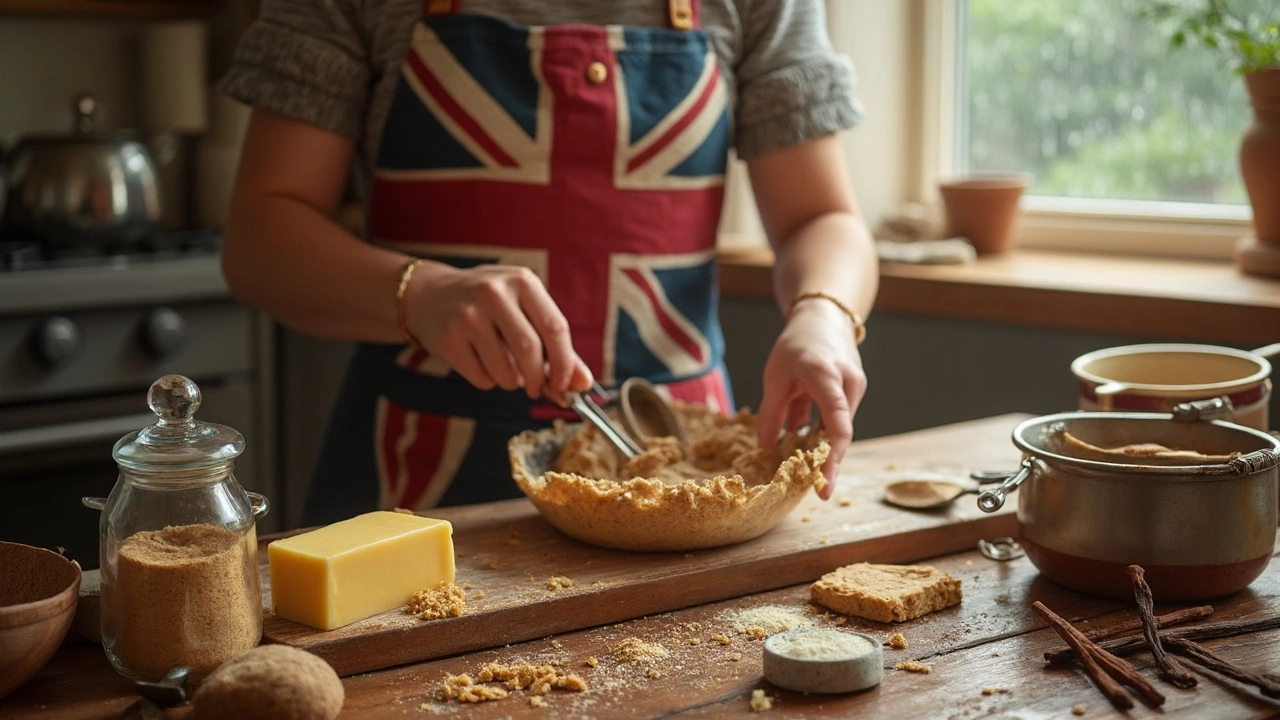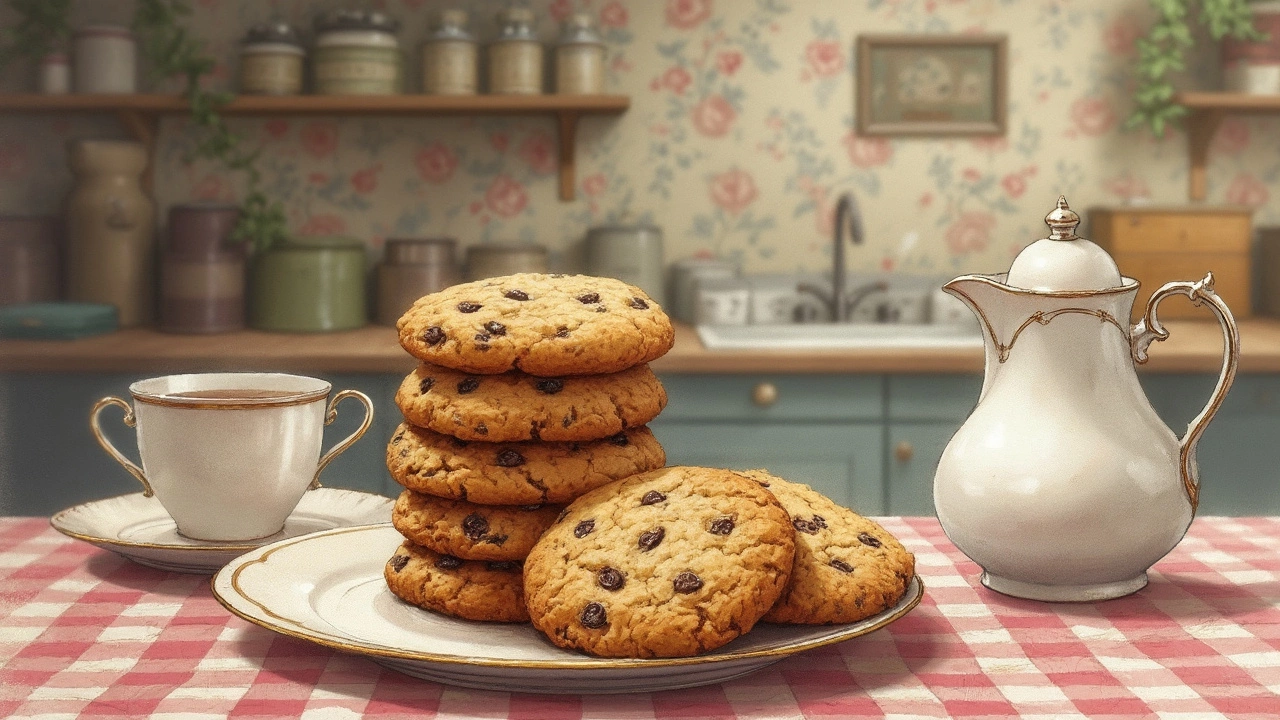
Have you ever wondered why some cookies end up crunchy while others stay as soft as a pillow? It's not just magic—it's all about what goes into them and how they're baked. First off, let's talk fats. Butter can make cookies soft because it melts at a lower temperature, spreading out more in the oven. Try margarine or vegetable shortening if you're going for the crisp factor instead.
Next up, sugar! Brown sugar is packed with moisture, so it tends to help cookies stay soft and chewy. Want crunch? Stick to granulated sugar; it produces a firmer texture. How you mix your ingredients is a big deal too. Over-mixing your dough can lead to too much gluten developing, which might make things tougher than expected.
But wait, there's more to the story! The baking time and temperature play huge roles. Low and slow might sound like a barbecue strategy, but if softer cookies are your jam, give it a shot. Meanwhile, blasting heat for a short time will likely yield that crisp snap.
- The Role of Ingredients
- Baking Techniques
- The Science of Texture
- Common Mistakes
- Pro Tips for Perfect Cookies
The Role of Ingredients
Why do some cookies crunch while others cushion? It's all about the ingredients you choose. Each one plays a key role in defining the final texture. Let’s break it down so the next time you’re mixing up a batch, you know exactly what each ingredient is bringing to the plate.
Butter vs. Shortening
Butter is your go-to for cookie softness. Why? It melts at a lower temperature than vegetable shortening, which allows your dough to spread more in the oven, leading to a softer texture. Want thicker, crunchier cookies? Go for shortening! It remains solid for longer, creating cookies that hold their shape better.
Sugar Science
Sugar choice seriously influences texture. Brown sugar contains more moisture due to its molasses content, which helps create soft, chewy cookies. If you're aiming for crunch, white granulated sugar is your best bet, as it produces a harder dough.
Flour Factors
Flour type is no minor detail either. All-purpose flour is versatile and widely used, but if you want a tender cookie, consider cake flour. It’s lower in protein, resulting in less gluten formation, which keeps cookies soft.
The Magic of Eggs
Eggs bind ingredients, but they also add moisture and fat, contributing to chewiness. Using more egg yolks than whites can make your cookies richer and softer, whereas cutting back on eggs can sometimes give you a firmer texture.
| Ingredient | Impact on Texture |
|---|---|
| Butter | Softness |
| Shortening | Crispness |
| Brown Sugar | Chewiness |
| White Sugar | Crispness |
Don't underestimate baking soda and baking powder either—they're the unsung heroes. Baking soda spreads while baking powder puffs, impacting how your cookies rise and ultimately, how they feel when you bite in.
Baking Techniques
When it comes to baking, it's not just about throwing everything in the oven and hoping for the best. There are a few essential techniques that can really affect whether your cookies turn out just right. Let's dive into some of these methods that can help make your homemade cookies perfect, whether you like them crisp or chewy.
Timing and Temperature Matter
The first thing to wrap your head around is that the baking time and temperature can drastically change your cookie’s texture. If you're after a chewy texture, consider baking for a shorter time at a lower temperature. Think around 325°F (163°C). For crunch, you might up the ante to about 350°F (177°C) and bake them for a bit longer.
Choosing Your Cookie Sheet
Your baking sheet isn't just a cookie holder; it plays a part too! Dark, non-stick sheets tend to absorb more heat, which can lead to a crispy bottom. Lighter sheets are great if you prefer a more even bake and a softer texture.
Position in the Oven
Where you place your tray in the oven also counts. Middle rack is the baking sweet spot. For crispier cookies, try the upper rack to get them closer to the heat.
Cooling Rates
How you cool your cookies affects their final texture. Leaving them on the baking sheet post-oven will continue to cook the undersides, making them crisper. Moving them to a cooling rack right away keeps them softer.
- Chewy Cookies: Shorter baking time at lower temperature, lighter trays, and cooling on racks.
- Crispy Cookies: Longer time at higher temperature, darker trays, and cooling on sheets.
Crank up your cookie game by paying attention to these small but mighty factors. It’s all about knowing what textures you're after and tweaking these variables to suit your baking goals.

The Science of Texture
Let's dive a bit deeper into what makes cookies soft or crunchy. It's astonishing how a tweak here and there in your ingredients and baking process can change everything. We're talking chemistry in the most delicious form.
Understanding Ingredients
The types of sugar you use are crucial. Brown sugar has molasses, giving cookies more moisture and a soft, chewy texture. On the flip side, granulated sugar is dry, promoting a crunchy cookie finish. The fats matter too. Butter is more than just a favorite flavor; its moisture content also adds to the chewiness.
Role of Temperature
Temperatures aren't just a number on the oven dial—they're a call to action in the kitchen. Baking at a lower temperature lets cookies spread and cook slowly, typically leading to softer cookies. High heat quickly evaporates moisture, perfect for those who like a bit of crunch. Ever tried adjusting mid-bake? If you know your oven and your preference, upping or lowering those degrees can work wonders.
The Gluten Factor
Here comes the gluten part. Over-mixing dough creates strong gluten strands, which ultimately firm up the cookie. But not all flours are equal. All-purpose flour is balanced, but if you fancy a soft cookie, a touch of cake flour could be the secret aisle of magic.
Moisture and Starch
Adding an extra egg yolk increases fat content for a richer, softer cookie. And for keeping that baked good moist over time? Starch can be a lifesaver. Cornstarch, for instance, helps hold onto moisture longer, ensuring fresh textures days after baking.
Mastering the science of cookie texture is all about understanding these elements and knowing when to play with them. It’s like conducting a mini-experiment every time you step into the kitchen, with delicious results.
Common Mistakes
When it comes to nailing the perfect homemade cookies, a few common errors can sneak up on even the best of us. One biggie? Using the wrong kind of flour. If you're after a chewy texture, all-purpose flour is your friend. But if you overdo it, your cookies might spread too much or end up more like rocks than delicious treats.
Over-baking
Another trap many fall into is over-baking. The second your cookies start showing color at the edges, yank 'em out! Remember, they'll keep cooking as they cool. Want a soft result? Finish the bake a little sooner rather than later.
Ignoring Ingredient Temperatures
Ignoring ingredient temperatures is another pitfall. Butter that's too cold won't cream properly, while melted butter can lead to flat, pancake-like cookies. Room temperature is usually the sweet spot.
Skipping the Chill Time
And let's not forget skipping the chill time. Seriously, putting your dough in the fridge for even 30 minutes can make a world of difference, especially for chewy recipes. This firms up the fat so your bleeds aren't too flat.
Misjudging Measurements
Miscalculating your ingredient amounts can also lead you astray. Use a kitchen scale for accuracy — it's worth the small investment. A heavy hand with baking soda or salt can result in cookies that taste like, well, disappointment.
Steer clear of these common mistakes, and you're well on your way to baking addiction-worthy results!

Pro Tips for Perfect Cookies
Are your cookies feeling a bit too hit-or-miss these days? Let's get things back on track with some pro tips to up your baking game. Nailing the perfect homemade cookies comes down to a few tweaks and tricks that are easy to follow.
Pick the Right Ingredients
Not all flours are created equal. For a chewier cookie, consider using bread flour. It has more protein, creating a stronger gluten network. If a softer cookie is your goal, stick with all-purpose flour.
Chill That Dough
Here's a top secret: chill your dough. It firms up the fat, leading to less spread in the oven. This chilling time is like magic, helping flavors meld together for a better-tasting cookie. Aim for at least 30 minutes in the fridge.
Mind Your Baking Time
Some of the best bakeries pull out cookies before they look done. They keep cooking on the hot pan! Err on the side of under-baking for a chewy inside. Let them rest for a few minutes on the sheet after you take them out.
Storage Matters
Once baked, how you store cookies can change a lot. Soft cookies like a sealed container with a slice of bread to maintain moisture. Crunchy cookies do better in a tin with a loose lid.
Keep Notes
Every oven is a bit different. Keep a cookie journal, jotting down what worked and what flopped. You'll find what makes your perfect cookie faster than you think!
Extra Baking Hacks
- Use parchment paper for an even bake and easy cleanup.
- For even baking, rotate your cookie sheets halfway through the cooking time.
- Measure precisely; baking is a science! Consider getting a kitchen scale.
There you have it! With these solid tips, your cookies will be a whole lot closer to perfection. Remember, practice makes perfect, so don't hesitate to bake often and enjoy the delicious results.